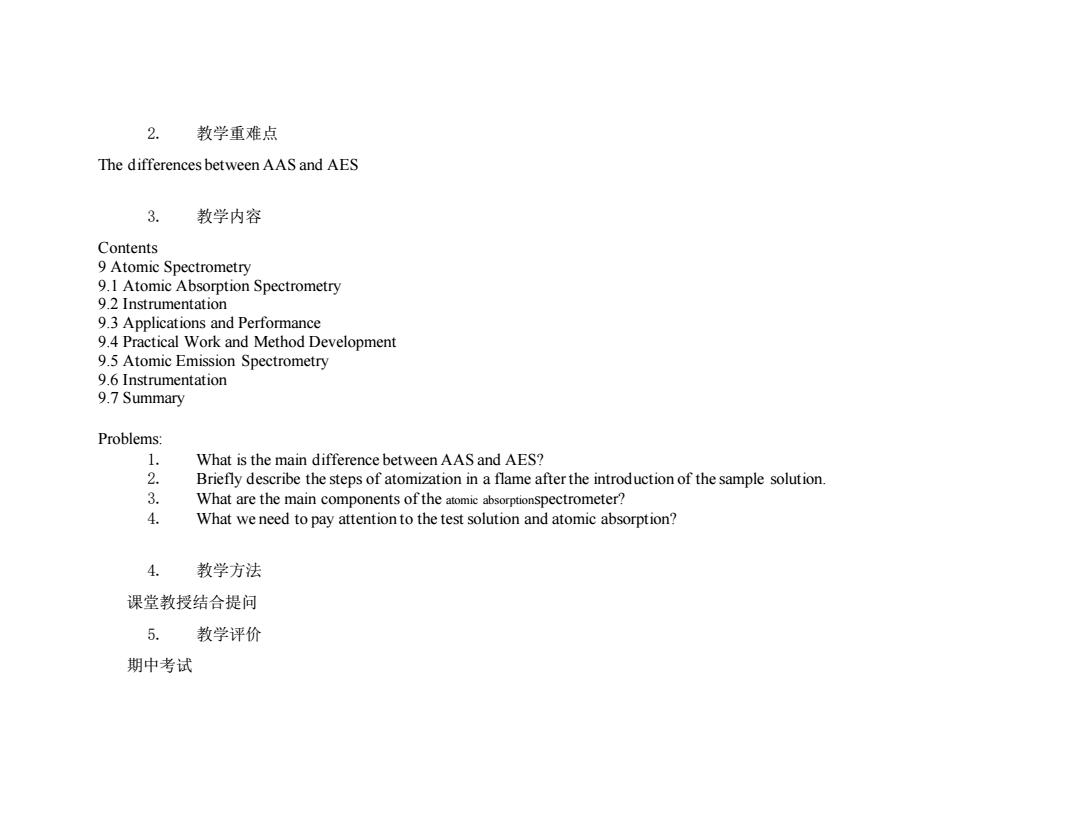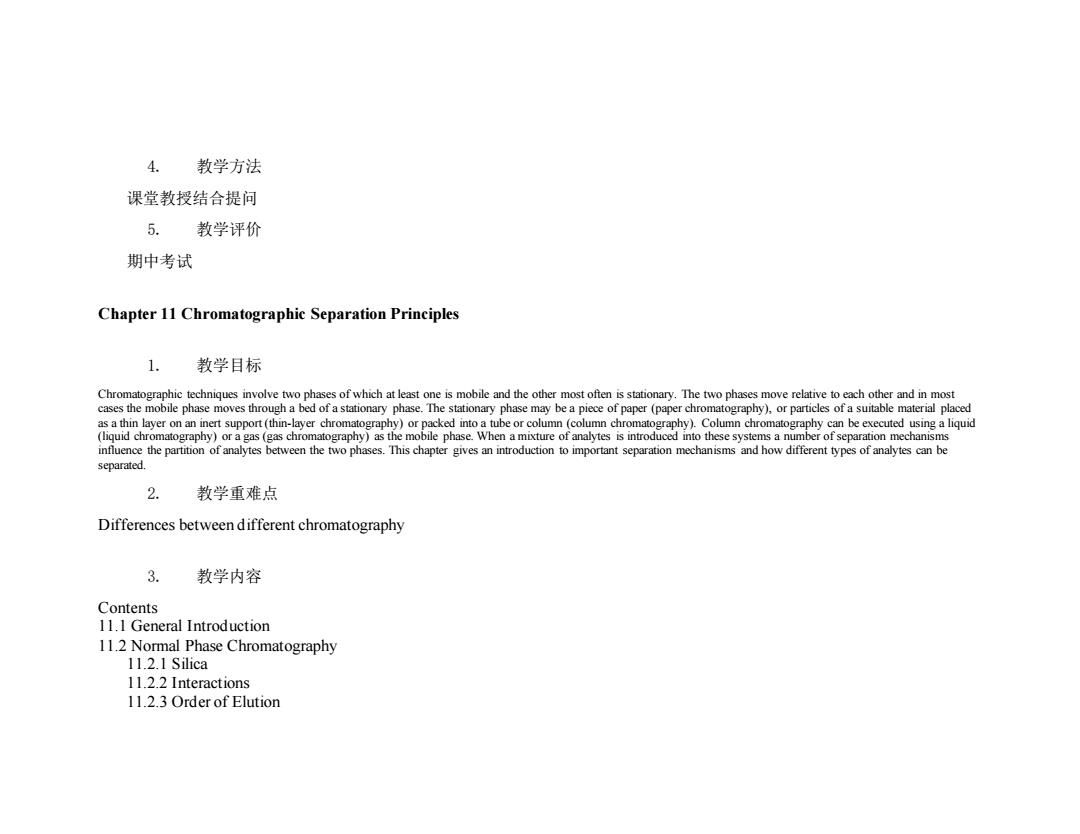
2. 教学重难点 The differences between AAS and AES 3. 教学内容 Contents 9 Atomic Spectrometry 9.1 Atomic Absorption Spectrometry 9.2 Instrumentation 9.3 Applications and Performance 9.4 Practical Work and Method Development 9.5 Atomic Emission Spectrometry 9.6 Instrumentation 9.7 Summary Problems: 1. What is the main difference between AAS and AES? 2. Briefly describe the steps of atomization in a flame after the introduction of the sample solution. 3. What are the main components of the atomic absorptionspectrometer? 4. What we need to pay attention to the test solution and atomic absorption? 4. 教学方法 课堂教授结合提问 5. 教学评价 期中考试
2. 教学重难点 The differences between AAS and AES 3. 教学内容 Contents 9 Atomic Spectrometry 9.1 Atomic Absorption Spectrometry 9.2 Instrumentation 9.3 Applications and Performance 9.4 Practical Work and Method Development 9.5 Atomic Emission Spectrometry 9.6 Instrumentation 9.7 Summary Problems: 1. What is the main difference between AAS and AES? 2. Briefly describe the steps of atomization in a flame after the introduction of the sample solution. 3. What are the main components of the atomic absorptionspectrometer? 4. What we need to pay attention to the test solution and atomic absorption? 4. 教学方法 课堂教授结合提问 5. 教学评价 期中考试

Chapter 10 Chromatography 1. 教学目标 Chromatography is the name give to a particular family of separation methods where the separation is based on differences in rates of migration when the sample components are transported by a mobile phase through a stationary phase.The mobile phase can be a gas,a liquid or a supercritical fluid and the stationary phase may be a solid,a liquid or a gel. Chromatography is considered the most important analytical technique in pharmaceutical analysis.This chapter looks at the theory of chromatographic separation and at important parameters used to characterize a separation. 2. 教学重难点 Principles of chromatography 3. 教学内容 Contents 10.1 General Principles 10.2 Retention 10.3 Column Efficiency 10.4 Selectivity 10.5 Peak Symmetry 10.6 Resolution 10.7 Chromatographic Techniques 10.8 Summary Problems: 1. What is the mean of chromatogram?What is an idealized chromatogram? 2. What are the means of tr,tM,k,N,H,a,and Rs? 3. How to determine the column efficiency from the peaks in the chromatogram? 4. How to improve separation by altering a value? 5. How to evaluate the resolution?
Chapter 10 Chromatography 1. 教学目标 Chromatography is the name give to a particular family of separation methods where the separation is based on differences in rates of migration when the sample components are transported by a mobile phase through a stationary phase. The mobile phase can be a gas, a liquid or a supercritical fluid and the stationary phase may be a solid, a liquid or a gel. Chromatography is considered the most important analytical technique in pharmaceutical analysis. This chapter looks at the theory of chromatographic separation and at important parameters used to characterize a separation. 2. 教学重难点 Principles of chromatography 3. 教学内容 Contents 10.1 General Principles 10.2 Retention 10.3 Column Efficiency 10.4 Selectivity 10.5 Peak Symmetry 10.6 Resolution 10.7 Chromatographic Techniques 10.8 Summary Problems: 1. What is the mean of chromatogram? What is an idealized chromatogram? 2. What are the means of tR, tM, k, N, H, α, and Rs? 3. How to determine the column efficiency from the peaks in the chromatogram? 4. How to improve separation by altering α value? 5. How to evaluate the resolution?

教学方法 课堂教授结合提问 5. 教学评价 期中考试 Chapter 11 Chromatographic Separation Principles 1. 教学目标 Chromatographic techniques involve two phases of which at least one is mobile and the other most often is stationary.The two phases move relative to each other and in most cases the mobile phase moves through a bed of a stationary phase.The stationary phase may be a piece of paper (paper chromatography),or particles of a suitable material placed as a thin layer on an inert support(thin-layer chromatography)or packed into a tube or column(column chromatography).Column chromatography can be executed using a liquid (liquid chromatography)or a gas(gas chromatography)as the mobile phase.When a mixture of analytes is introduced into these systems a number of separation mechanisms influence the partition of analytes between the two phases.This chapter gives an introduction to important separation mechanisms and how different types of analytes can be separated. 2. 教学重难点 Differences between different chromatography 3. 教学内容 Contents 11.1 General Introduction 11.2 Normal Phase Chromatography 11.2.1 Silica 11.2.2 Interactions 11.2.3 Order of Elution
4. 教学方法 课堂教授结合提问 5. 教学评价 期中考试 Chapter 11 Chromatographic Separation Principles 1. 教学目标 Chromatographic techniques involve two phases of which at least one is mobile and the other most often is stationary. The two phases move relative to each other and in most cases the mobile phase moves through a bed of a stationary phase. The stationary phase may be a piece of paper (paper chromatography), or particles of a suitable material placed as a thin layer on an inert support (thin-layer chromatography) or packed into a tube or column (column chromatography). Column chromatography can be executed using a liquid (liquid chromatography) or a gas (gas chromatography) as the mobile phase. When a mixture of analytes is introduced into these systems a number of separation mechanisms influence the partition of analytes between the two phases. This chapter gives an introduction to important separation mechanisms and how different types of analytes can be separated. 2. 教学重难点 Differences between different chromatography 3. 教学内容 Contents 11.1 General Introduction 11.2 Normal Phase Chromatography 11.2.1 Silica 11.2.2 Interactions 11.2.3 Order of Elution